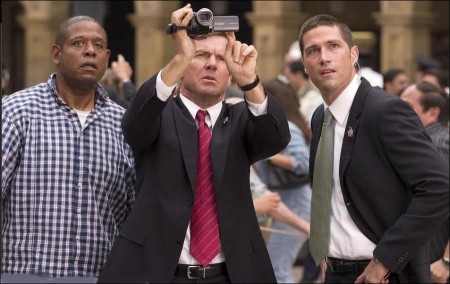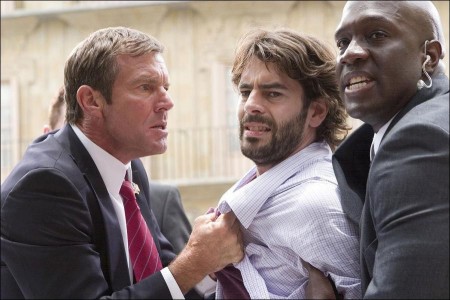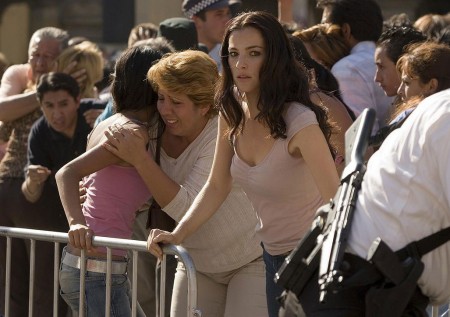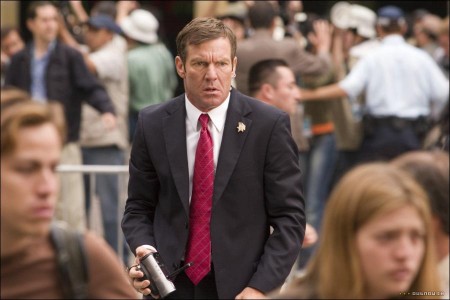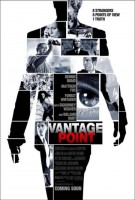Tagline: 8 strangers, 8 points of view, 1 truth.
In Columbia Pictures’ action-packed thriller Vantage Point, eight strangers with eight different points of view try to unlock the one truth behind an assassination attempt on the president of the United States. Thomas Barnes (Dennis Quaid) and Kent Taylor (Matthew Fox) are two Secret Service agents assigned to protect President Ashton (William Hurt) at a landmark summit on the global war on terror.
When President Ashton is shot moments after his arrival in Spain, chaos ensues and disparate lives collide in the hunt for the assassin. In the crowd is Howard Lewis (Forest Whitaker), an American tourist who thinks he’s captured the shooter on his camcorder while videotaping the event for his kids back home.
Also there, relaying the historic event to millions of TV viewers across the globe, is American TV news producer Rex Brooks (Sigourney Weaver). As they and others reveal their stories, the pieces of the puzzle will fall into place — and it will become apparent that shocking motivations lurk just beneath the surface.
About the Film
The President of the United States is in Spain to deliver a major address on terrorism. As he approaches the podium in a crowded square, shots ring out, and pandemonium breaks loose. The president falls to the ground.
This is the setting for Columbia Pictures’ new film Vantage Point, an action-thriller that, for director Pete Travis, was a chance to explore the idea of “the truth” — and the fact that truth is in the eye of the beholder. As Vantage Point unfolds, the film explores the period immediately before and after the assassination attempt from the unique points of view of eight key participants — ranging from the president himself to the Secret Service agents assigned to protect him to a tourist in the square only by chance. “If you were to follow only one story, you wouldn’t find out the truth about what really happened,” says Travis. “As you see each story, you see something else that you never knew before. It’s only when you get to the end that you figure out what really went on.”
Travis points out that in addition to the five well-known American stars and four highly regarded international actors that topline Vantage Point, there is one more star: the story. “You’ve got eight different people, eight ways of seeing the world, eight pieces of a puzzle. It’s a dream for a director: you can’t solve the mystery of this film without seeing the world from different people’s point of view. It’s a story that you can only tell through cinema. A movie about ways of `seeing’-how cool is that!”
For Dennis Quaid, who stars in Vantage Point, the film was a chance to subtly shade a performance based on point of view. “There’s the way we see ourselves, and there’s the way others see us,” he explains. “I play my character one way when the story is told from my point of view, but when the film’s vantage point shifts to another character’s POV, I play him as that character sees him — and change again for the other characters. A person isn’t seen the same way by any two people.”
Screenwriter Barry L. Levy adds that those multiple points of view lead to chaos — and only through mutual understanding can the truth come out. “Everyone knows only what they can see before their eyes, what they can figure out, which limits everyone’s understanding of what’s going on,” he says. “Only when the audience sees the collective, all eight stories, all eight pieces of the puzzle, will they understand what really went on. Ultimately, the movie is a single story, a hero’s journey — but told from eight points of view.”
To bring Levy’s idea to the screen, producer Neal H. Moritz tapped Travis, whose first film as a director, Omagh, focused on a 1998 bombing in Northern Ireland. “The way Pete captured reality, the characters, the sound, was entirely original,” says Moritz. “Pete’s fresh approach to the material made it clear to me that Vantage Point would be in good hands.”
Travis and Levy were keenly aware that the film they were making, by its nature, required seeing the same actions over and over again, from different points of view. “We had to keep it fresh,” Travis says. “When you see something more than once, we tried to make sure that you were seeing something different. For example, when you first see the square, you see it as the news cameras see it — lots of cameras, but far away and static or up close and handheld, the way a news program would shoot it. When you see it from a Secret Service agent’s point of view, it’s like walking into an amphitheater, and you hear a noise you didn’t hear before. The crowd, which had previously seemed friendly, looks different to a Secret Service man who’s just coming back a year after being shot. Every face in the crowd is a potential assassin; every wave of the flag could be a signal to somebody. I tried to shoot that in a way that shows what he feels, so that the story would feel different every time.”
Moritz says that the filmmakers called upon every tool available to differentiate the stories. “Whether it was through the use of different lenses, or different film stock, or lighting, or different ways of shooting, such as handheld cameras, Steadicam, dollies, we used different tricks to try to make each of these stories feel individual, to keep the audience interested in the twists and turns and invested in each character’s story.”
After filming, Travis found one more way to keep the story fresh: “When we came to cutting the film, we made sure that every story ended with a cliffhanger. Only at the end do all the stories get wrapped up and you figure out what went on.”
And all eight stories are necessary, according to Quaid. “It’s a puzzle, this film, and if you take one piece out, you can’t see the whole picture,” he says.
The film features a cast of award-winning actors, including Dennis Quaid, Matthew Fox, Forest Whitaker, William Hurt, and Sigourney Weaver, and rising international stars, including Spain’s Eduardo Noriega (star of Abre los ojos, the original version of Vanilla Sky), Israel’s Ayelet Zurer (Munich), France’s Saïd Taghmaoui (La Haine), and Venezuelan actor Edgar Ramirez (The Bourne Ultimatum).
Quaid says that he was attracted to the film by the chance to work with the director. “I had seen Pete’s previous movie, Omagh, which is about an IRA terrorist bombing in Ireland. I like his realistic style of filmmaking; there’s a lot of action. His movies are gripping — you know you’re watching actors, but they have the immediacy of a documentary.”
Fox says that the twists and turns of his character were immediately appealing. “I’m fascinated with the concept of perspective,” he says. “It’s a great opportunity to play a guy who you think is one way but turns out to be someone completely different.”
Whitaker, who just last year won the Academy Award® for Best Actor for his performance in The Last King of Scotland, adds, “When I met Pete, he told me his background-he was a social worker before he made movies! Talk about a different perspective! In that first meeting, I wanted to do this movie, and fortunately, it worked out.”
Quaid adds that Vantage Point represented an opportunity to delve back into an action film. “I didn’t realize while reading this script how much action there is in this movie, but we’ve got gun shots, bombs going off, terrific car chases-all exciting stuff and fun to do. For me, it was like being a kid again to do all the action.”
Travis says that the action underscored the ideas in the film. “What’s exciting about the action is that it shows you something in a way that you didn’t see it before. It becomes part of the point of view,” he says. “There’s a visceral, hand-held kinetic energy of the camera — the idea is to make it a participant in the action. When people run, the camera runs with them; when people go into a room, the camera goes in behind them. During the car chase, when the car is hit and the camera is spinning around inside the car, that’s our fabulous stunt coordinator, Spiro Razatos, holding the camera and getting hit.
To bring the car chase to life, Travis and Razatos looked at their favorite car chases for inspiration, then planned out their own in minute detail. “We sat down with a bunch of toys and planned every single stunt and storyboarded everything to make you feel, how does it feel to be really in a chase?
“In a way, it’s a point of view thing,” he continues. “When you see Dennis Quaid driving, the camera behind him, looking over his shoulder at what he’s chasing, it’s not just seeing him chasing someone; instead, you’re in there with him, chasing with him, and it’s more real and more exciting.”
Moritz was excited to make the film as an homage to one of his favorites. “Rashomon is a four-star classic, and while that movie is in a league of its own, it’s a thrill to explore some of the same themes,” he says. “Even with the best intentions, we all interpret events differently. If a movie can excite you about an idea, and feature an awesome car chase as well, that’s the best of both worlds.”
Casting the Film
Vantage Point features an all-star cast, with each actor getting to be the star of the show for his or her segment. Dennis Quaid says that his character’s challenges and problems helped to underscore the film’s central tension — that is, that events are determined by one’s point of view. “Barnes is a guy who took a bullet for the president and this is his first day back on the job,” he explains. “He has a lot of trepidations about being back and it’s made him jumpy and quick to react-too quick, as it turns out, because sometimes his gut instinct is wrong. But ultimately, you’re not paranoid if it turns out that you’re right.”
“Dennis Quaid has always been the all-American hero, ever since The Right Stuff and The Big Easy,” says Travis. “That’s what I’ve always loved about him — he’s quintessentially American, an old-fashioned movie star, a proper man’s man. He’s tough, yet vulnerable. That’s what this part needed, a man who was torn inside. Everybody treats him as a hero, but the last thing he wants to be is a hero — he’s just doing his job. Dennis brought a real sensitivity to that part. And he has the kick-ass car chase, as well.”
Matthew Fox plays Quaid’s partner, Secret Service Agent Kent Taylor. As Agent Barnes’ longtime confidant, Taylor is in a unique position. “Dennis and Matthew’s story is really about brothers, in a way. These two men look out for each other. Taylor is sticking up for his mentor, who is having a tough time coming back after being shot. Everything changes when the president is shot — that relationship is put under the microscope.”
As a result, Travis sought an actor who could hold his own next to Quaid. “Like Dennis, he’s the all-American hero,” Travis says. “There’s a wonderful authenticity to Matthew that I really like — he has a wonderful energy about him and the ability to surprise you.
Fox was excited by the project’s structure. “When the movie rewinds and you go back and watch what my character was doing, your whole perspective changes: `Oh my God! He was actually doing something different!’
“It’s exciting for an actor,” Fox continues. “Any time you get a chance to play with different aspects of your performance, playing up emotions or mannerisms, to give a scene different meanings — it’s incredibly gratifying. In this film, that’s built in — it’s part of the story.”
Fox was also glad for the chance to work especially closely with Dennis Quaid. “Dennis’s character is more than just a mentor to mine — he’s like a brother,” says Fox. “It’s an intense bond that they have. Dennis is a great actor, and to be able to explore the relationship between these two guys with him was a real thrill.”
Forest Whitaker, who plays an ordinary man named Howard Lewis, joined the cast early on after a meeting with Travis. “Omagh was so powerful, so strong, so honest,” he says. “Working with him was one of the main reasons I wanted to join this film. He’s got a good soul.”
“Unlike the other characters, Howard Lewis is an ordinary man,” says Travis. “Most of us will never be the president, or a Secret Service agent, or even a news producer. He’s the everyman — never been to Spain, never been that close to the president, excited to film it and take the pictures home to his kids — and suddenly finds himself the little man at the center of this huge story. He’s the guy who never got picked for the football team who desperately wants to be the hero and this is his chance.”
Whitaker enjoyed his chance to be in an action movie. “Howard does a lot of running,” he laughs. “During filming, not only would I run, but I’d run for blocks and blocks. We’d just keep going. It seemed like for two months, all I did was run. Everyone was making a lot of jokes about it.”
William Hurt prepared for the role of playing the president of the United States by interviewing a man who knew about the job firsthand: President Clinton. “I know his time is valuable and didn’t want to waste his time, so I was very direct,” Hurt says. “President Clinton was extremely refreshing and honest. I asked him what it is like to have the knowledge that you represent something that a lot of people want dead. He said that if you weren’t ready for that before you tried to get the job, then you shouldn’t even take the next step.
“I also asked him about accepting the scope of responsibility that comes with the job,” Hurt continues. “He said, `Well, it’s easier if you live over the store.’ And that’s the case — the president goes downstairs when he goes to work.”
Keeping in mind the president’s advice, Hurt relished the opportunity to change his performance when he is portraying the president as others see him, as opposed to the part of the film that depicts the president’s point of view. “When others see him, it’s interesting to see him walk through a mixed crowd of people, some of whom like him, some of whom dislike him, all sandwiched side-by-side,” he says.
Travis admired the commitment that Hurt made to his character and portraying the role. “The way Vantage Point is structured, each actor is the star of the film for fifteen minutes,” he says. “William Hurt showed up in Mexico, and for his first six weeks, he walked into a plaza, raised his arms, got shot, and fell backwards. That was it, over and over again, for six weeks. And he never complained once, because he knew that when we got to his story, he would be the star.”
Travis was also impressed by the way Hurt plays the leader of the free world. “I’m not an American, but he’s the kind of president that I would want to vote for,” he says. “Not because of his politics — I don’t know what his politics are and I don’t particularly care — but he’s a decent man, he’s a smart man, he’s a moral man, he wants to do things for the right reason. That’s what I love about him — our story pits that man with a huge moral dilemma. This is the defining moment of his presidency and his career and his future totally rest on this one decision. William portrayed that beautifully.”
Travis was not alone in that regard. “Towards the end of filming, we were shooting a sequence with him and the crew — who were all Mexican citizens — were so overwhelmed by the emotion of the scene. One of them came up to me and said, `I never thought I would care about the American president that much.’ William Hurt makes you care about him. It’s not about politics, he’s just a guy you care about.”
For Sigourney Weaver, playing TV news producer Rex Brooks was a chance to play a character whose primary interest is transporting the audience into the news. “She is definitely a news junkie,” says the Academy Award® nominee. “Rex is a driven and inspired news visionary. When she finds herself at the epicenter of this attack, she’s like a kid in a candy store. She’s getting the shots and painting the canvas; she’s quite controlling about what goes over the airwaves.”
To prepare for her role, Weaver spent time in a newsroom at a major network. While there, she witnessed the reporting of the story of the arrest of the British terror suspects who were accused of plotting to bring down airplanes with liquid explosives. “It was a big `breaking news’ day and I got to see people in a crunch,” says Weaver. “They were so focused, gobbling up every detail, making sure that what they sent out was appropriate and also truthful. For instance, they were very careful not to mention the elements that could be used to make a bomb.”
Vantage Point is also distinguished by performances from several acclaimed international stars. Pete Travis says each brings something unique to the roles: “Eduardo Noriega is a huge star in Spain and I’m sure he’ll become a star in America, because he’s got great charisma. He’s a man driven by passion and jealousy at the beginning of the film — he thinks his girlfriend is cheating on him — and he discovers that life can be even worse than that. Ayelet Zurer — when I saw her in Munich, I found her to be wonderfully charismatic. I wanted somebody who could be a bit of everything — she needed to be bad, but also vulnerable. Saïd Taghmaoui is a huge star in France. When I saw him in La Haine, which is his breakout movie, he has a ferocious intensity to him. Edgar Ramirez looks great with a gun — he’s a trained killer who wants to give up his job, but is forced by circumstances to do one more thing. You’re never really sure with Edgar if he’s good or bad, and that’s really exciting for an actor.
About the Production
For the filmmakers, it was necessary to set the film in a foreign location: it would add to the confusion that was required for the story. In researching possible locations, they fell in love with one location in particular: Salamanca, Spain, and its central square, Plaza Mayor. “It was critical that the film was set in Salamanca,” Travis says. “There is no one worldview in this film. You can’t figure out who shot the president by following only the American heroes; you have to watch all the stories, and since the picture is about us all, the film had to be set in a foreign location. In addition, I wanted this film to have heat, a sexy intensity, an exotic allure. That could only be Spain.”
The filmmakers found the perfect location in Salamanca, a town a short distance from Madrid. According to Travis, the filmmakers soon fell in love with the town’s central square, Plaza Mayor. “It’s a spectacular plaza, an enclosed square that feels like an amphitheatre, full of life and culture, but also a place that would be scary as hell if it had 30,000 people fleeing for their lives,” he says. “It’s grand and eloquent, the ideal setting for a world summit, and it’s never been seen in a big movie before. It’s perfect.”
However, as the pre-production process began, it became clear that shooting in Salamanca was not meant to be; with an action-packed script that required explosions, gunfights, and car chases, the Salamanca location simply did not give the filmmakers the flexibility they needed to pull off a production of this magnitude. With Plaza Mayor itself off the table, the filmmakers began to look for locations that could double for Salamanca and found what they were looking for in Mexico City. “When we had to find another place, we wanted to come to a country that had the contrast and intensity that you get in Spain. We found it in Mexico,” says Travis.
The challenge for production designer Brigitte Broch-who won the Academy Award for her set decorating work on Moulin Rouge-was immediate: rebuild an exact replica of Plaza Mayor in Mexico City, and do it in a way that the filmmakers can blow it up.
To build this plaza, the production discovered an ideal place in the southern part of Mexico City. Executive Producer Callum Greene explains, “We found an abandoned four-story mall which became a perfect area for us. We built our construction, carpentry, metal work, and plastic shops in the abandoned mall. Next to it was a pit where we built our Plaza Mayor.”
Moritz says, “In a city of 25 million people, it’s hard to find any empty land, so I consider it fate that it worked out for us. We were able to build our plaza in a place where we had total security, total privacy, and even weather protection, because we were in the pit. We were able to go back to Salamanca and shoot certain scenes there; the two blended together seamlessly. You really can’t tell what was shot in Spain and what was shot on our set.”
It took ten weeks, working seven days each week, with over three hundred workers to construct the set. “On a film set, everything must be done faster than you ever thought you could achieve it,” Broch says. “When you have a great crew, somehow, it all gets done — and it comes out looking spectacular.”
In the end, Moritz says, “our Plaza Mayor was a masterpiece. I couldn’t be more impressed with the work that Brigitte and her team did on this movie.”
Travis adds, “You could have brought people from Salamanca and they would have thought they were in Spain.”
Whitaker says, “The plaza set really blew me away! When I first walked in, I had the little camera because I was playing with it, and that’s when I was like `Wow, this is amazing!’ It looks so rich and full-especially with people in it.”
Broch says, “It’s always a good compliment when people say, `I didn’t know they did it on a set.’ That’s all one wants.”
The key advantage to building your own set is that everyone is excited when it’s time to blow it up. When the moment came, it was all hands on deck. Moritz sets the scene: “We had fifteen cameras filming the explosion, including three up close, with no operator. We had stuntmen moving with the explosion and extras ready to run. We wanted to give this moment of the film a very visceral feeling.”
Because of the way the film was shot — in a realistic, immediate manner — Moritz felt that it was important that the actors playing Secret Service agents have background training. To accomplish this, the filmmakers brought on board Ron Blecker, who, while serving a 15-year Army career, trained real-life Secret Service agents in the art of protecting the president of the United States; in addition, as a soldier, Blecker himself served on two presidential details. “It was essential that Dennis, Matthew, and the rest of the actors playing Secret Service agents, including the background actors, knew how real agents protect the president,” says Moritz. “What really impressed me about Ron’s suggestions was that not only were they realistic, but they usually also made the scene more dramatic and more exciting.”
Both before production and on set, Blecker advised Travis and Levy on the ins and outs of the Secret Service — tricks of the trade that came his way after years of Special Operations training. For example, Blecker notes, “Dennis Quaid’s character reacts to a guy in the crowd that pulls a camera. The initial reaction by the other agents was to pull a gun, but that’s not right. In fact, for the people closest to the president, their job is to blanket the president with their bodies. Pete was very interested in making those kinds of changes, to make the Secret Service scenes as realistic as possible.”
Three weeks before the start of production, Blecker arrived in Mexico. His first order of business was to find 35 background actors to be Secret Service agents. “The casting department located 3,000 people, and I met and talked to every single one. We eventually got our list down to 60, and those 60 came in and did some basic maneuvers, training, and weapon familiarization. From there, Pete and I picked the 35 background actors.”
Then, one week out from production, Blecker began training the actors. “The first thing we did was weapon familiarization,” he says. “Most of the actors had handled guns in movies before, but Secret Service does things just a little differently, so I taught them how to pull and aim their weapons and move with a gun.
“Then, we went through movement tactics,” Blecker continues. “We brought in hundreds of extras. We showed them how to move through the crowd, how different formations worked, what each person’s responsibility would be, what they had to look for. Then we went through drills — somebody would come at the president with a gun, then with a knife, then an emergency call would come in on the radio — and got them trained on how to work as a team.”
On the final day of training, Blecker introduced the team to his most difficult training assignment, the “Rescue Dean” exercise. “I’ve got a 175-pound duffle bag with a padlock on it and no handles. This bag represents `Dean,’ the president’s son, who has been kidnapped. I hid the bag at the studio and handed the actors a ransom note. They had a certain amount of time to find `Dean’ and return him to me, a mile away. There was a whole scenario — I made it as difficult as possible, because it’s this kind of training that gets people who don’t know each other very well to gel as a team. As cliché as it sounds, it was Dennis Quaid who delivered that 175-pound duffle bag across the finish line at the very end. You couldn’t have scripted it any better.
Production notes provided by Sony Pictures.
Vantage Point
Starring: Dennis Quaid, William Hurt, Matthew Fox, Sigourney Weaver, Forest Whitaker, Zoe Saldana, Edgar Ramirez, Eduarodo Noriega, Shelby Fenner
Directed by: Pete Travis
Screenplay by: Barry Levy
Release Date: February 22, 2008
MPAA Rating: PG-13 for sequences of intense violence and action, some disturbing images, strong language.
Studio: Sony Pictures
Box Office Totals
Domestic: $72,266,306 (47.8%)
Foreign:$78,822,733 (52.2%)
Total: $151,089,039 (Worldwide)
